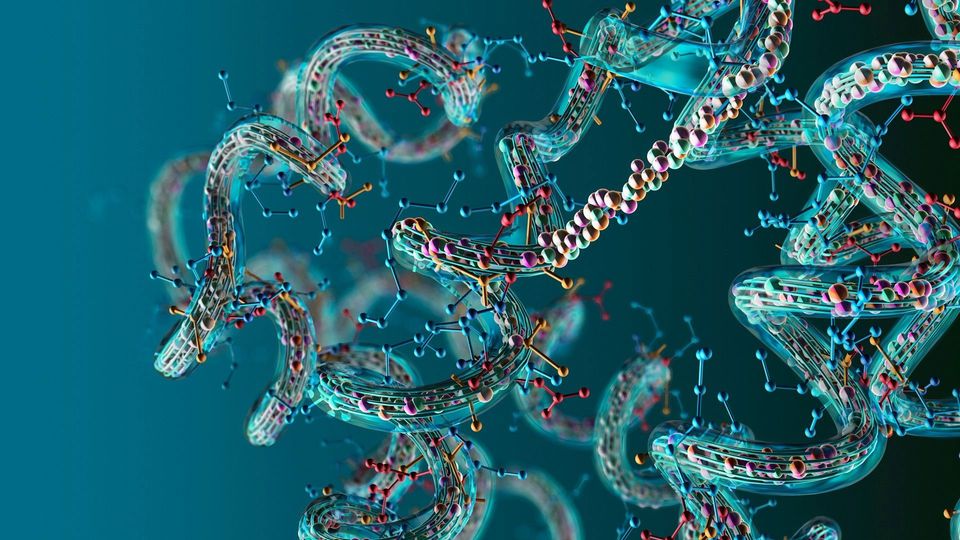Decoding the Aging Process With Mass Spectrometry
Mass spectrometry offers powerful new ways to decode aging, from whole-body clocks to organelle dysfunction.

Complete the form below to unlock access to ALL audio articles.
Understanding the molecular mechanisms that underpin aging has long captivated scientists. As age is a major risk factor for most chronic diseases, quantifying and potentially slowing biological aging could improve both quality of life and healthcare outcomes. Mass spectrometry (MS) has emerged as a critical tool in aging research, enabling detailed exploration of aging at the protein and cellular levels.
This article explores how MS and emerging analytical techniques are helping researchers decode the proteome at multiple scales – from plasma to specific tissues to individual organelles – unveiling the hidden rhythms of aging and the potential for early, individualized interventions.
Predicting biological age with proteomic aging clocks
Aging is not solely defined by the number of years lived. Increasingly, researchers emphasize biological age – a molecular measure of an individual’s health status that more accurately reflects disease risk and functional decline. Among the most promising tools for assessing biological age are proteomic aging clocks, which leverage patterns in plasma protein expression to estimate biological age and forecast health outcomes.
“We now know that aging and related diseases are accompanied by distinct proteomic changes and a reduced ability to generate high-quality proteins through proteostasis machinery,” said Dr. Nathan Basisty, tenure track investigator at the National Institute on Aging. “Proteomic approaches, including both MS-based and probe-based proteomic methods, have enabled researchers to measure and profile these changes with unprecedented molecular depth, specificity and throughput.”
One of the largest studies in the field used UK Biobank data to analyze 2,897 plasma proteins from over 45,000 individuals, constructing a proteomic aging clock that predicted chronological age with high accuracy. Proteomic aging was also strongly associated with the incidence of 18 chronic diseases – including cardiovascular disease, cancer, neurodegeneration and diabetes – and correlated with key aging traits such as telomere length, frailty index and cognitive performance.
Importantly, the clock maintained its predictive power across diverse populations, performing well in independent cohorts from China and Finland. The proteins most predictive of aging were involved in immune response, extracellular matrix remodeling and hormone regulation – highlighting aging as a complex, multi-system process. These insights point to a future in which proteomic clocks may enable earlier intervention and personalized strategies to delay or prevent age-related diseases.
In another study co-authored by Basisty, researchers profiled 1,301 plasma proteins from 997 individuals, aged 21 to 102, to uncover age-associated changes in protein expression, disease burden and lifespan. Of the proteins analyzed, 651 showed age-related trends – 506 increased with age, while 145 decreased. Many were involved in inflammation, extracellular matrix dynamics and the senescence-associated secretory phenotype.
Using these data, the team developed a 76-protein signature to estimate an individual's proteomic age (PROage). The difference between PROage and chronological age – referred to as PROaccel – was predictive of accelerated disease accumulation and increased mortality risk, especially in individuals over 65. A positive PROaccel indicated that a person was biologically older than their chronological age based on proteomic data, and these individuals tended to have a higher burden of comorbidities.
“One of the patterns that surprised me was the observance of specific inflection points during which massive changes occur in the circulating proteome,” said Basisty. “These changes, which occur in our 40s and again in our 60s, have been reproducibly observed by multiple research groups. Understanding the importance and relevance of inflection points in aging is an interesting and outstanding question in the field.”
Aging is tissue-specific
While plasma proteomics provides a broad overview of biological aging, the aging process is inherently tissue-specific. Different organs undergo distinct molecular changes that contribute uniquely to disease risk and functional decline.
A recent study published in Nature Communications integrated the Orbitrap Astral Mass Spectrometer and tandem mass tag labeling to explore these organ-level nuances.
The researchers profiled more than 12,000 proteins across the cortex, hippocampus, striatum and kidney in male and female mice at 3, 12 and 20 months of age – roughly equivalent to humans aged 20 to 60 years.
Their findings revealed tissue-specific aging trajectories. While brain regions exhibited primarily age-related proteomic changes, the kidney showed alterations driven by both age and sex.
Importantly, the study identified linear and non-linear changes in protein abundance over time, highlighting the complex and sometimes abrupt molecular shifts associated with aging. Synaptic proteins in the brain followed distinctive developmental and aging trajectories, offering valuable insights into the mechanisms behind cognitive decline and neurodegeneration.
Seeing aging at the subcellular level
As aging progresses, dysfunction often begins at the organelle level – within mitochondria, the endoplasmic reticulum (ER) and their interface known as mitochondria-ER contact sites. These structures are central to energy production, protein folding, calcium signaling and lipid metabolism. Their breakdown underlies many age-related diseases, including neurodegeneration and metabolic disorders.
Mass spectrometry imaging (MSI) now allows researchers to visualize these changes in situ at cellular and subcellular resolution – without dissociating tissues. A recent study highlights how high-resolution MSI can track organelle dysfunction in aging models, revealing disruptions in mitochondrial calcium homeostasis, elevated reactive oxygen species, ER stress and nicotinamide adenine dinucleotide depletion.
These stress-induced changes drive inflammation, senescence and tissue degradation. By mapping the spatial distribution of metabolites and proteins, MSI provides a powerful lens to understand how organelle-level dysfunction unfolds with age and contributes to disease.
From whole-body to organelle: A multi-scale aging map
Together, these MS techniques build a multi-scale portrait of aging – from systemic biomarkers in plasma, to tissue-specific protein trajectories, to cellular and organelle disruptions.
Basisty noted that combining proteomic aging clocks with tissue-resolved proteomics and MSI “provides a different perspective on the aging proteome and could potentially be combined to paint a more detailed and complete picture of the aging process. For example, tissue-resolved proteomics can be used to generate organ-specific aging clocks to better understand the relative pace of aging in different organs.”
This integration is essential, as no single measure fully captures the complexity of biological aging.
Tackling the challenges of proteomic aging biomarkers
Despite rapid progress in proteomics, translating proteomic data into actionable biomarkers of aging – particularly from blood – remains a significant challenge. Blood is the most accessible tissue for longitudinal human studies, yet its complexity presents unique obstacles.
“One of the major technical challenges with proteomic biomarkers is the vast dynamic range of protein concentrations in blood,” said Basisty. “The most abundant proteins are at least 10 orders of magnitude higher than the lowest, making it extremely difficult to detect many low-level proteins with good biomarker potential.”
Fortunately, recent advances in technology are expanding the detectable range of the plasma proteome. “In recent years, new workflows and technologies have substantially increased the proteomic depth that can be achieved in blood and other high dynamic range samples. For example, in our recent study in Nature Aging, we applied a nanoparticle-based processing approach to greatly improve the number of senescence-associated proteins we could detect with downstream mass spectrometry,” he explained.
Another challenge lies in the systemic nature of blood. “Blood perfuses all of our tissues, so we cannot easily attribute a change in a protein to a specific tissue or organ,” Basisty noted. To overcome this, researchers are developing innovative strategies to localize signals.
“Recent work from Dr. Hamilton Se-Hwee Oh and Dr. Michael Snyder at Stanford University proposed organ aging signatures in plasma and modelled aging in individual organs. Interestingly, they found that accelerated organ aging, based on proteomics, is associated with disease risk. Our lab is similarly developing tissue-specific senescence signatures in blood. I believe that attributing proteomic changes in blood to specific tissues will open novel individualized and targeted therapeutic opportunities,” he said.
Looking ahead, Basisty sees potential for proteomics to drive advances in aging research. He believes “proteomics holds enormous potential to accelerate ‘translational geroscience’, or the development of interventions that target aging biology.” Basisty identifies two major opportunities: “first, identifying protein biomarkers to quantify biological age, predict future health and measure the effectiveness of interventions; and second, uncovering novel therapeutic targets and mechanisms underlying age-related functional decline.”
He is also encouraged by the growing adoption of proteomic technologies. “I am excited about the growing embrace of proteomic approaches among researchers in aging biology. In my view, there are so many promising MS workflows that can and should be applied in the context of translational geroscience, and simply not enough people to do the experiments,” he said. “There is still a long way to go to make MS workflows accessible to biologists and clinicians, but the appreciation and adoption of these approaches are increasing and will certainly help fill in some of the missing studies.”
Technological advancements are further fueling momentum in the field. “It is also exciting to see the speed, sensitivity, resolution and versatility of mass spectrometers increasing rapidly. These improvements are pushing the limits of the proteomic depth we can achieve with the throughput necessary to conduct large cohort studies,” Basisty added.
Finally, Basisty pointed to a critical frontier that remains largely unexplored: proteoforms.
“I am excited by the development of improved methods to identify and quantify proteoforms, a term that captures the diversity of proteins arising from splicing, gene variants and post-translational modifications. Most applied untargeted proteomic workflows are blind to proteoforms, so we are missing out on an entire world of molecules,” he said.
“I think proteoform-level analysis will unlock more sensitive and specific biomarkers, and novel insights into protein functions,” Basisty concluded.





